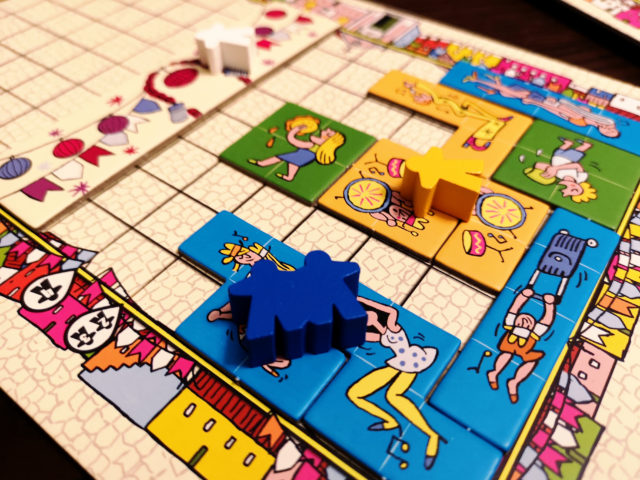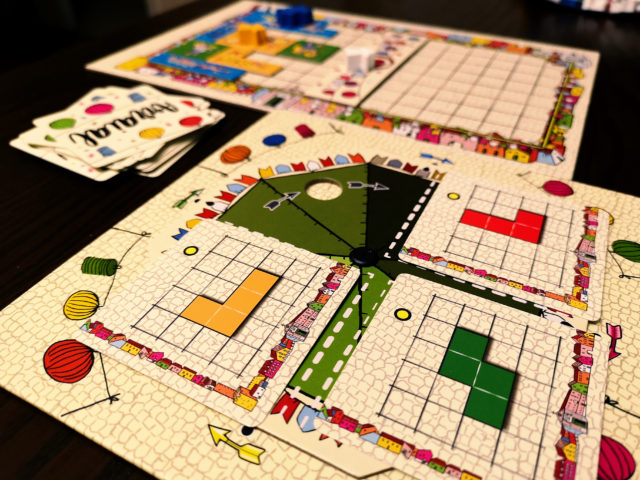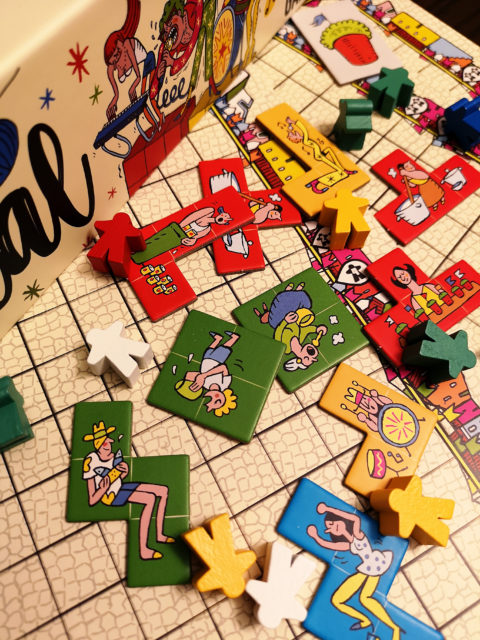During the summertime in Portugal, communities host arraial, fantastic celebrations held in streets and neighbourhoods for dancing, eating and more. Portuguese designers Nuno Bizarro Sentieiro and Paulo Soledade took the flair and colour of these joyful parties and translated it into Arraial, a light polyomino game where players are gathering revellers onto their party boards. It’s a delightful representation of these summer parties (image searches return great bursts of colour and movement!) – and it’s even thematic enough that the President of the Portuguese Republic was toting it around at a recent arraial! Get your party gear on and get ready to dance – or at least grab a Caipirinha and put your polyomino-arranging brain into gear.
When I first tried this game, I really wasn’t sure what it was all about. I’d seen it out on tables at BGGcon last year (after its European release) and the colour and illustrations gave it real life. Sitting down to play, I felt it interesting to think you’re essentially trying to lure the better “people” (that is, certain pieces) to your party, and end up with the most visitors to your street. So, Arraial might look like a party, but how does it play?

Over three rounds, players take and place coloured polyominos on their street board. The most interesting angle of this for me, one that makes this stand out among all sorts of polyomino-based games, is the rigidity of each shape’s orientation when you take it. That is, when you select one of the three cards from the central board you must place the shape it indicates in that exact orientation onto your board. No, you can’t rotate it or anything that’ll make things nice and easy! Where’s the fun in that? Partygoers come as they are, after all.
With three action points every turn, you can use them variously for rotating the wheel of pieces and for taking/placing the polyominos of visitors. In the first two rounds, you have to place at least one piece; the kicker is in the last round you must place two, which can get tricky with limited space on your street. So, rotating the central board to make your options/orientations of tiles more desirable is key. Although, sometimes, you’re stuck with who you get. As the game progresses you’re looking to create groups of tiles of one colour that attract visitor meeples (points at the end of the game) and to finish horizontal lines on your street board – bumping up your party banner. Not only does this allow you to have new visitors come to the party at the end of the round (white meeples, not specific to any colour tile group) but more importantly – more space for tiles! Every turn I worry that I’ll end up having to take a piece that just won’t fit usefully anywhere and end up crossing the party banner. This isn’t great, as you’ll end up without the ability to have those new visitors join your party as the banner is removed from your board. It hasn’t happened yet, but I can imagine it’d be a setback.

Outside of the white visitor meeples, every section of one colour that’s 2+ tiles will invite a visitor of that colour – that is, a meeple – to be placed there. If you currently have the largest grouping of one colour, the “couple” meeple of matching colour will come to visit you. If you’re on top of things and keep that majority for the rest of the game, they’re worth some extra points! But it can be beaten and the couple will move onto someone else’s party. This part of the player interaction is fairly benign. It’s really the manipulation of that centre player board that can ruin someone’s turn. While you don’t have 100% control over what shape players will take on their turn, you can make things difficult for them. Being able to see what colour pieces are coming up thanks to the face-up draw cards allows players to plan somewhat before refilling the board once their turn is over. I might take a card and then rotate that central board twice, then refill that empty spot so that all of the orientations of the pieces aren’t ideal for other players and where their street boards are situated. The basics of Arraial are just that – and who doesn’t love a good puzzly polyomino game? But it’s nice to have a little challenge involved when it comes to it. A little spatial dance, if you will.
Of course, as I mentioned above, the art really stands out for Arraial. Bright colours and fanciful illustrations of the various people partying make this a little more fun than if it were simply a block-colour abstract game. Singers, folks making food, couples dancing all fill up your street board – which itself is lined with colourful houses – and don’t forget the level bar festooned with flags and lanterns and the like. It wasn’t until I needed a rule refresh that I knew the start player marker has a little story behind it, which I think is delightful! The Manjerico is seen at feasts and festivals during the summertime in Portugal, where “it is customary for young men to offer their girlfriends a potted basil plant, along with a small flag carrying a romantic message.” Potential suitors: I’ll always choose a pot of herbs over a bunch of flowers!

Over a number of plays, I have felt I’ve enjoyed Arraial at 3 and 4 players best – thinking of the slightly mean ways you can mess with the central board in a 2p game without a buffer of other turns between you and opponents makes me a little wary! There is a solo version of the game offered (easily done by removing the colour majority aspect of the game and randomly drawing colour piece tiles), which could offer a decent puzzle if folks were interested. As a lot of solo versions tend to do, you’ll be comparing your score at game-end to a table of results of varying levels – the lowest of which is less than 10 points, accompanied by the comment “Was there even a party?” Ouch.
If you’re a little burnt out on polyomino games, I understand. From Uwe Rosenberg alone there’s been a glut of titles in the past few years. At its heart, Arraial is still is that Tetris-feeling vibe of geometric goodness – but it’s got a little something more to it with the colour area control and the strict orientation of tiles. Games like Bärenpark (driven by the placement of tiles over icons allowing you to select other specific tiles) and Feast For Odin and Princes of Florence (with particular placement rules for tiles) offer up these flourishes on top of the basic puzzle that keep me going back to them. Compared to games similar to its weight – titles such as Scarabya, and even some of the Rosenberg series – it has the same edge with the flavour of theme adding to the attraction and gameplay of the abstract undergrowth. I feel like it’s accessible enough for more casual gamers to enjoy too, which is something I tend to look at more and more these days. It doesn’t matter if someone’s familiar with any polyomino game, they can be drawn in by Arraial’s theme and enjoy the quick play and puzzle of the game. And if you are familiar – well, it might provide a delightful surprise!
—
Arraial is a tile placement game for 1 – 4 players, and plays in approximately 30 minutes. Designed by Nuno Bizarro Sentieiro and Paulo Soledade, with art by Nuno Saraiva, it’s published by MEBO Games and Pandasaurus Games. I’d like to thank the Pandasaurus folks for getting us a review copy!
Comments
No comments yet! Be the first!